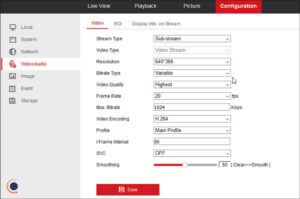
If you have been dealing with security cameras, you’ll probably have heard the term bit rate. It’s important to understand the bit rate and how to use it in your security system. In this guide, we will give a deeper understanding of bit rate and how this parameter impacts the performance of your CCTV security camera system.
![]() What Does Bit Rate Mean in Security Camera Systems? (Part II)
What Does Bit Rate Mean in Security Camera Systems? (Part II)
The bit rate in security videos (and not only) is essentially the amount of data that’s being sent by the video feed. Another way to think of bit rate is based on the video quality. More data (thus, a higher bit rate) the better the quality of the video. But that comes with certain limitations.
Obviously, there’s more to the technical aspect of the bit rate, but that’s all you need if you want to know just the bit rate meaning and purpose in the CCTV or IP camera systems.
Bit rates are noted by a Kilobits per second or “kbps”. For example, 128, 256, 512, 1024, 2048, 4096 and up (doubling in each iteration). These values can be adjusted and modified to match your requirements. The higher this number, the better the image quality of your footage.
Where to locate the Bit Rate settings in my security camera system?
This depends on your security equipment model and make. The bit rate settings can be found on the camera’s or recorder’s configuration panel. Usually, the bit rate is found under the device configuration settings and it is labeled Video, or Image, or Stream settings. For example, the screenshot below shows the video settings for a Hikvision camera.

In most CCTV systems, there are two main bit rate types that can be selected: VBR and CBR. Below we will explain what these parameters mean.
VBR stands for Variable Bit Rate, which means the bit rate will fluctuate in value depending on what’s happening in the scene. More activity/ or motion leads to a higher value of bitrate. Less activity leads to a lower value of the bitrate.
When VBR is selected, the bit rate value should be set to the highest setting (maximum bit rate) and then the system will adjust it automatically. VBR allows the system to use a high bit rate for scenes with a motion, and low when there’s no motion. This way you’ll have high-quality images on important scenes (with motion), and low-quality images for scenes with minimal motion.
CBR stands for Constant Bit Rate, which means the bit rate value will stay the same regardless of what type of activity is going on the screen. This value will not fluctuate higher or lower from the value set on the device by the user/installer.
CBR can be useful in certain scenarios where consistent quality is an absolute requirement but it will have a negative impact on the number of storage days (on the hard drives). On CBR, the data is constantly being used and that will take more space on the hard drives.
To conclude: the VBR features use high bandwidth for important scenes, and low for unimportant ones. The CBR uses the same amount of bandwidth (bit rate per second) regardless of the type of scene. In other words, VBR will save more space on the hard drive.
Source: Security Cam Center



































































